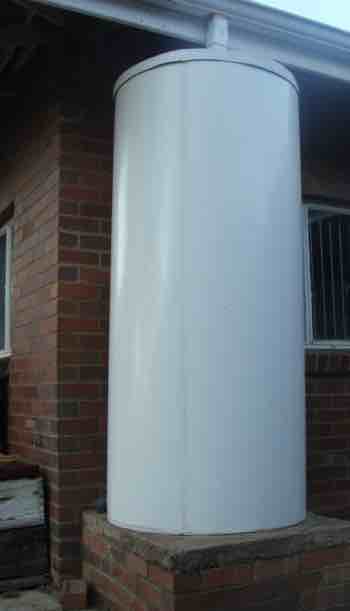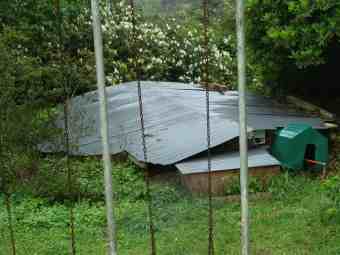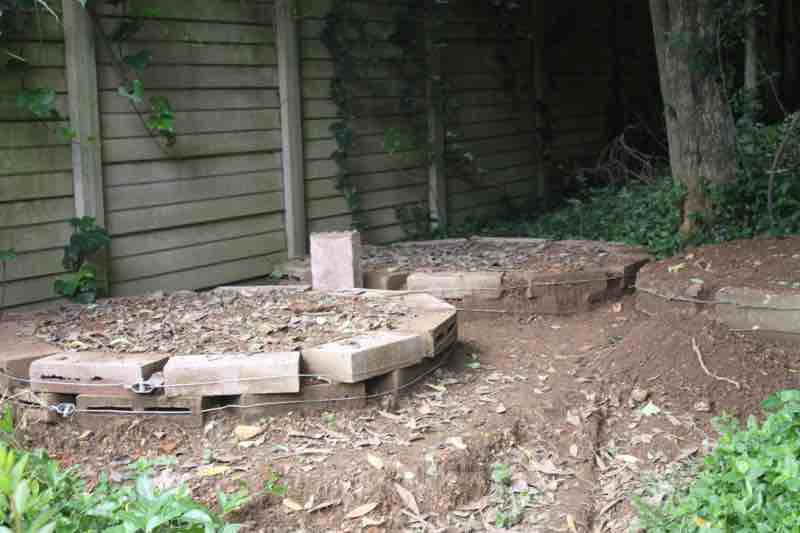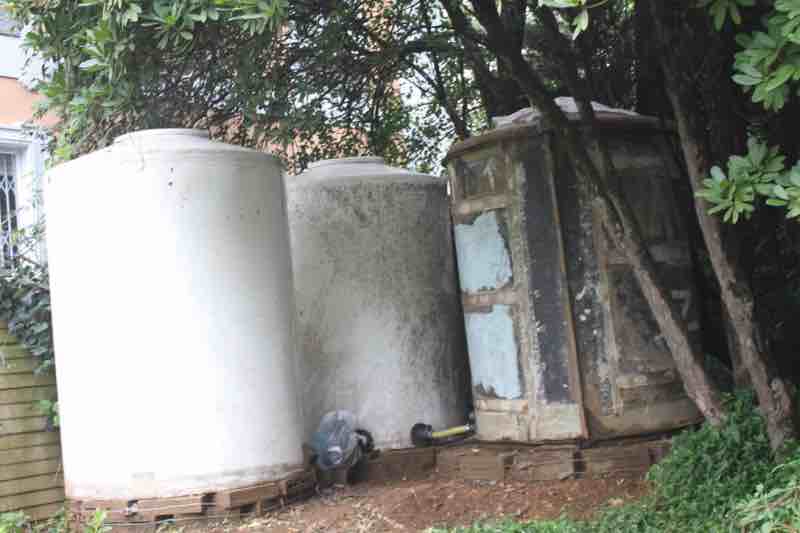Suburban rainwater tanks
Suburban rainwater tanks asks what volume you would need to plan for your home and garden, and gives thoughts on an underground reservoir, rather than plastic or fibre-glass storage chambers.
According to Wikipedia[1] nearly half of the world's population has to rely on in-home water storage due to a lack of reticulation. In some ways they have an advantage; it is probably cleaner with no plastic particles and other contaminants.
We have both systems; each has its merits. Having done it piecemeal my conviction is to do your planning first, and then build a big enough reservoir that will store sufficient water for a drought. Raising the wall is complex; better to do it right from the start.

This page was last updated by Bernard Preston on 21st February, 2022.
- Bernard Preston homepage
- Harvesting Rainwater
- Rainwater tanks
Roof area
The factors to consider are the size of your roof from which you can harvest rainwater, and the length of your dry-season.
It is relatively easy to collect rainwater from about half your roof-area; it is certainly possible to harvest more, but it does get more difficult.
Let us say you have an average 200 m2 roof, and you are planning on harvesting from half of it; just for nice round figures, that makes 100 square-metres.
- Bernard Preston homepage
- Harvesting Rainwater
- Rainwater tanks
That is about 1,100 square feet.
If you have 100 mm of rain for say 10 months, then you can harvest about ten cubic-metres of water every four weeks; 2649 gallons, depending on where you live naturally.
In the Sahara desert is would be rather less obviously.
That is about enough for an average family, so assuming it rains at regular intervals, which it will not, of course, you could get away with a 2,500 litre tank for the wet-season.
One 5,000 litre suburban rainwater tank would provide enough storage for two weeks. If the weather is fickle for a month, and you can top up from the utility, then you would be fine.
If not, to be safe, you would need 10 kilolitres of storage, or 2649 gallons, to be more exact.
That is two large 5,000 litre tanks, each about five-times the size of that shown above.
Dry season
But of course there is going to be a dry season, lasting say three-months when you may not have a drop of rain; then you are going to need 30,000 litres of storage, if you are unable to access municipal water.
In our case we almost always get some winter rain, so we planned for 27,000 litres of storage.
That means you would need six 5,000 litre suburban rainwater tanks.
Only twice in nearly nine years have we run short, when the spring-rains were later than expected; by one month. For this reason, we remain connected to the utility, though we use almost none.
Suburban rainwater tanks
Suburban rainwater tanks recommends you store your harvest from the skies underground because it is so much colder, and less unsightly.
The temperature of the water in above-ground storage chambers, even if they are made of concrete, rises quite high, and unfriendly bacteria may flourish; it will certainly not be potable.
You will have to rely on bottled water for drinking.
Underground reservoir

Whilst I am not a disbeliever in suburban rainwater tanks, and we now have five at our home, for mass storage we think an underground-reservoir is a cheaper and better solution.
One would need to get an engineer to draw up plans, or I might in the future provide ours as an eBook; dig a large hole and have a contractor lay a slab with reinforcing.
Then build a double brick-wall, with reinforcing, which would need to be plastered. It was surprisingly inexpensive.
Admittedly I did the plumbing and the electrics from our solar generator myself. But even so, it is not a lot of money to invest in an underground reservoir and to connect it into your home and garden.
It is a sublime supplement to your suburban rainwater tanks.
Underground the water is seriously cold, which means it is probably potable[2]. We drink it without reservation, and have done so for more than eight years.
Newsletter
Our newsletter is entitled "create a cyan zone" at your home, preserving both yourself and Mother Earth for future generations; and the family too, of course. We promise not to spam you with daily emails promoting various products. You may get an occasional nudge to buy one of my books.
Here are the back issues.
- Lifestyle and ideal body weight
- What are ultra-processed foods?
- Investing in long-term health
- Diseases from plastic exposure
- Intensive lifestyle management for obesity has limited value
- A world largely devoid of Parkinson's Disease
- The impact of friendly bacteria in the tum on the prevention of cancer
- There's a hole in the bucket
- Everyone is talking about weight loss drugs
- Pull the sweet tooth
- If you suffer from heartburn plant a susu
- Refined maize meal and stunting
- Should agriculture and industry get priority for water and electricity?
- Nature is calling
- Mill your own flour
- Bake your own sourdough bread
- Microplastics from our water
- Alternative types of water storage
- Wear your clothes out
- Comfort foods
- Create a bee-friendly environment
- Go to bed slightly hungry
- Keep bees
- Blue zone folk are religious
- Reduce plastic waste
- Family is important
- What can go in compost?
- Grow broad beans for longevity
- Harvest and store sunshine
- Blue zone exercise
- Harvest and store your rainwater
- Create a cyan zone at your home
It is lovely
and soft, and free of chlorine. We have actually put in a UV-device to
sterilize it, with a charcoal filter mostly just to keep the family happy.
It also tastes a lot better than chlorinated stuff from the utility. But how safe is our drinking water?
There is a strong body of scientific evidence that we have been amiss in trying to sterilise everything in our environment. There are a great many good bugs that help develop our immune systems.
It is astonishing that there are nearly five pounds of friendly bacteria, fungi and viruses in the normal alimentary canal; with twice as many cells as in a whole human body. Post chlorination can have a devastating affect on this community.
You cannot grow vegetables and fruit trees without water. Harvesting and using suburban tanks for storage, or a reservoir, is absolutely essential for any form of backyard permaculture.
A strong base

First you must set a sturdy and strong base for each of your suburban water tanks, capable of supporting five tons. Strengthen it with wire, using a puller to tighten it.
Fill the base of each with clay-type soil and compact it with a stamper. Then the tanks can be placed in position on these structures.
Simply making the reservoir one metre deeper, or greater in diameter really at a small expense, would have saved us a lot of schlep.

These extra water tanks were added after a particularly long winter drought lasting nearly six months. Now we should have enough no matter how arduous climate-change becomes.
Backyard permaculture
Working with nature, rather than against it, is the essence of backyard permaculture; it means having a reliable source of water in the dry season. If you are a serious gardener then harvesting and storing enough rain becomes a priority.
Ours is in the winter, lasting about three months long, though the odd shower is not unusual; without some form of suburban rainwater tanks for storage it would have been a hopeless pipe-dream.
There would today be no greens or broad beans. All demand a copious supply of water during the dry winter months.
When browsing use right click and Open Link in New Tab, or you may get a bad gateway signal.
Did you find this page interesting? How about forwarding it to a friendly book or food junkie? Better still, a social media tick would help.
- Bernard Preston homepage
- Harvesting Rainwater
- Rainwater tanks
Address:
56 Groenekloof Rd,
Hilton, KZN
South Africa
Website:
https://www.bernard-preston.com